Trips to memorial to the victims of world war II...
TEREZÍN - for more information about this trip you can click Recommended tours; Recommended trips
outside of Prague; tour number 10.
DACHAU - /10 miles north of Munich/
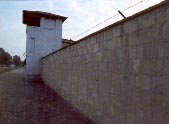
Dachau was the very first Nazi concentration camp, built in March 1933. More than 200.000 Jews,
political prisoners, homosexuals and others deemed‘ undesirable‘ by the Third Reich were imprisoned
in the camp; more than 30.000 died at Dachau and countless others died after being transferred to other
death camps. A visit includes camp relics, a memorial and a very sobering museum. Behind high walls and
watch towers of the camp, even today, more than half a century later, the horrors of Nazism have an
almost tangible presence. You can see the barracks the barracks and crematorium, the museum is in the
former working quarters, where shatering evidence of Nazi atrocities is displayed. Admission is free.
AUSCHWITZ - /cca 38 miles west of Krakow/
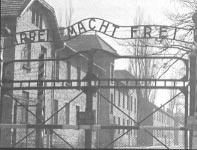
The Polish town of Oowiecim, about 60 km west of Kraków, may be unfamiliar to foreigners, but its
German name - AUSCHWITZ - is not. This was the Nazi’s largest concentration camp. Today it is possibly
the most poignant sight in Poland. The Auschwitz camp, established in April 1940, originally held Polish
political prisoners but eventually became a gigantic centre for the extermination of Europe’s Jews.
In 1941 the much larger Birkenau (Brzezinka) camp, also referred to as Auschwitz II, was built 2 km
/1,25 miles/ west of Auschwitz. These and other nearby death factories eliminated some 1.5 to two milion
people of 27 nationalities, about 85% to 90% of whom were Jews.
Auschwitz was only partially destroyed by the fleeing Nazis, and many of the original buildings
still stand as a bleak document of camp’s history. A dozen of the 30 surviving prison blocks house a
museum; some blocks stage general exhibitions; while others are dedicated to victims from particular
countries which lost citiziens at Auschwitz. From the visitor’s centre you enter the barbed - wire
encampment through the gate with the cynical inscripton "Arbeit macht frei" (Work Makes You Free),
visit exhibitions in the prison blocks and finally see the gas chamber and crematorium. A 15 - minutes
documentary about the liberation of the camp by Soviet troops on 27th January 1945 is screened at the
visitor's centre every halfhour.
BIRKENAU

It was actually at Birkenau, not Auschwitz, that the extermination of large numbers of Jews took
place. The vast purpose - built camp had over 300 prison barracks and four huge gas chambers. The camp
could hold 200.000 inmates at a time. In some ways, Birkenau is an even more shocking sight than
Auschwitz. Though much was destroyed by retreating Nazis, the size of Birkenau is overpowerig, fenced
off with long lines of barbed wire, watchtowers stretching almost as far as the eye can see.
At the back of the complex is a monument to the dead, flanked by the sinister remains of gas chambers.
FOR MORE INFORMATION IN CASE OF YOUR INTEREST, PLEASE FEEL FREE
TO CONTACT OUR TRAVEL AGENCY.
SVITAVY /BRUNLITZ, ZWITTAU/ - OSCAR SCHLINDLER’S HOME TOWN
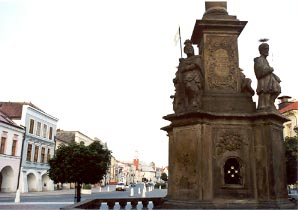
A local town on the river Svitava by the historical frontier of Bohemia and Moravia, for many
centuries the town was a church property. The forerunner of this town was a Slavic settlement from
second half of 12th century on the very important trading path from Prague to Olomouc. Round the year
1250 founded Bishop Bruno from Schauenburk in cheek by jowl with this settlement on the right bank of
Svitava river a new town, but the town in following years had suffered under the offten transits of
foreign troops. In the year 1800 here stayd overnight General Suvorov. In July 1866 Prussians here
attacked parts of Austrian and Saxon armoured units, which retreated to here after forfeit battle
at Hradec Králové.
AFTER MUNICH DICTATE IN THE YEAR 1938 Svitavy become to be part of German Reich. At the end of
Second World War worked here in military industry thousands of displayed workers, particularly from
France. /Totaleinsatz, general mobilization of civilians for war effort (implying displacement in Nazi
Protectorate of Bohemia and Moravia). In Svitavy have been produced among others components for missiles
W 1 and W 2. The town up today kept ancient ground plan /plot/ along busy tradig path, which exested
here from 12th century. This ancient ground plan reveals elongated square with a row of well preserved
Renaissance civic houses with the arcades. THE MUSEUM IN SVITAVY has historical exhibition inscribed
to the history of the town and a life of famous nativ OSCAR SCHINDLER, which name made so famous the
film "SCHINDLER’S LIST" of no less world famous american film director STEVEN SPIELBERG from film’s
first run in 1994. If you would like to learn more of the life of Oscar Schlindler and about
circumstances, under which he saved 1200 persecuted Jews, i can recommend you the book of EMILIE
SCHLINDLER WITH ERIKA ROSENBERG "WHERE LIGHT AND SHADOW MEET".
PUBLISHER: W. W. Norton Company, Inc., 500 Fifth Avenue, New York, N. Y. 10110; http://www.wwnorton.com
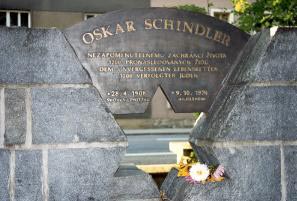
IN THE PARK OF THE TOWN YOU CAN SEE MEMORIAL
OF OSCAR SCHINDLER DEVOTED BY CITY HALL OF
SVITAVY TO COMMEMORATE NATIV OF SVITAVY,
WHO SAVED LIFES OF 1200 PERSECUTED JEWS.
KAZIMIERZ - JEWISH QUARTER IN KRAKOW
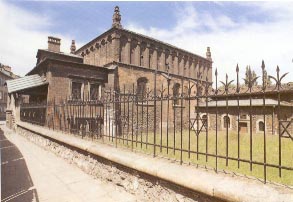
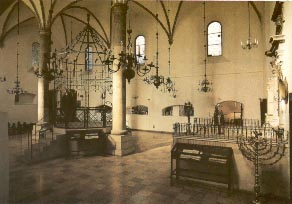
The old borough of Kazimierz, now within the city centre, was founded in 1335 by King Casimir The
Great, who intended it to be a rival to Cracov where burghers were mainly of German descent. Its centre
was a vast market place, not much smaller than the Cracow one, and the borough was encircled by wals,
whose remains can be still seen. In the late 15th century Jews were moved from Cracow to Kazimierz;
they lived there for centuries, until Warld War II, enjoying autonomy. Therefore, apart from monuments
of Polish history and culture, Kazimierz is particularly rich in the evidence of a specific and unique
Jewish material and spiritual culture. Polish history amd tradition is best symbolized in the Church
Na Skalce (the present 18th - century church was built on the site of the Romanesque one). According
to legend, Stanislaus, Bishop of Cracow, was killed there. The Polish kings used to make a pilgrimage
to that church before their coronation. The crypt now contains the tombs of distinguished Poles.
Other remarkable churches are the large three - ailed basilica of the Augustinian Canons, the purest
example of Gothic architecture in Cracow, and 14th - century Corpus Christy Church. In Wolnica Square,
which is what has remained of the original vast marked place, stands the 15th - century Town Hall,
much altered in later periods. JEWISH HISTORY AND CULTURE is represent by THE OLD SYNAGOGUE, the oldest
synagogue in Poland, originally Gothic but later rebuilt in the Renaissance style. Now it houses the
JUDAIC MUSEUM. Another fine complex consists of the 16th - century REMU’H SYNAGOGUE and the ADJACENT
CEMETERY; this smallest of the synagogues in Kazimierz is the only one where the Orthodox Jews worship
nowadays. At the outbreak of WW II was Kazimierz populated by about 70.000 Jews, who had been later
expelled from Krakow. During the war the Germans relocated Jews to a walled ghetto in Podgórze,
just south of the Vistula River, and then murdered them in the nearby Plaszów death camp. STEVEN
SPIELBERG’S FILM SCHLINDLER’S LIST tells the story (the Schindler factory is still there, at Lipová 4
in Podgórze, though it now houses the Telpold Electrical Works). THE CURRENT JEWISH POPULATION IS
ESTIMATED 100. DURING THE TOUR arround the Jewish quarter you will see eastern part of Kazimierz,
punctuated with synagogues that miraculously survived the war. Of these, the most important Old
synagogue, after short walk north you will see Remu’h Synagogue, the only synagogue open for services,
and finally Remu’h Cemetery boasts some extraordinary Renaissance gravestones.

IN CASE OF YOUR INTEREST, PLEASE FEEL FREE TO CONTACT OUR TRAVEL AGENCY
FOR MORE INFORMATION ABOUT THESE SPECIAL TRIPS.
home
|
